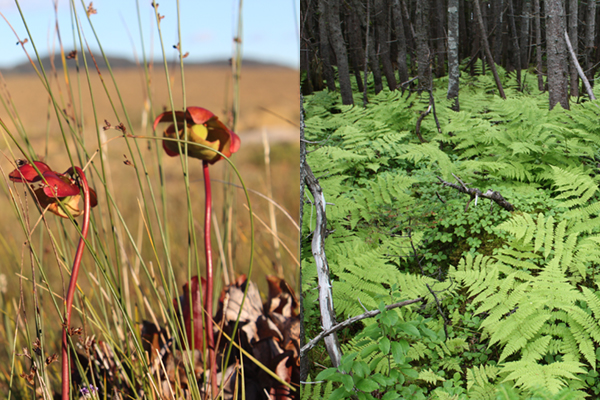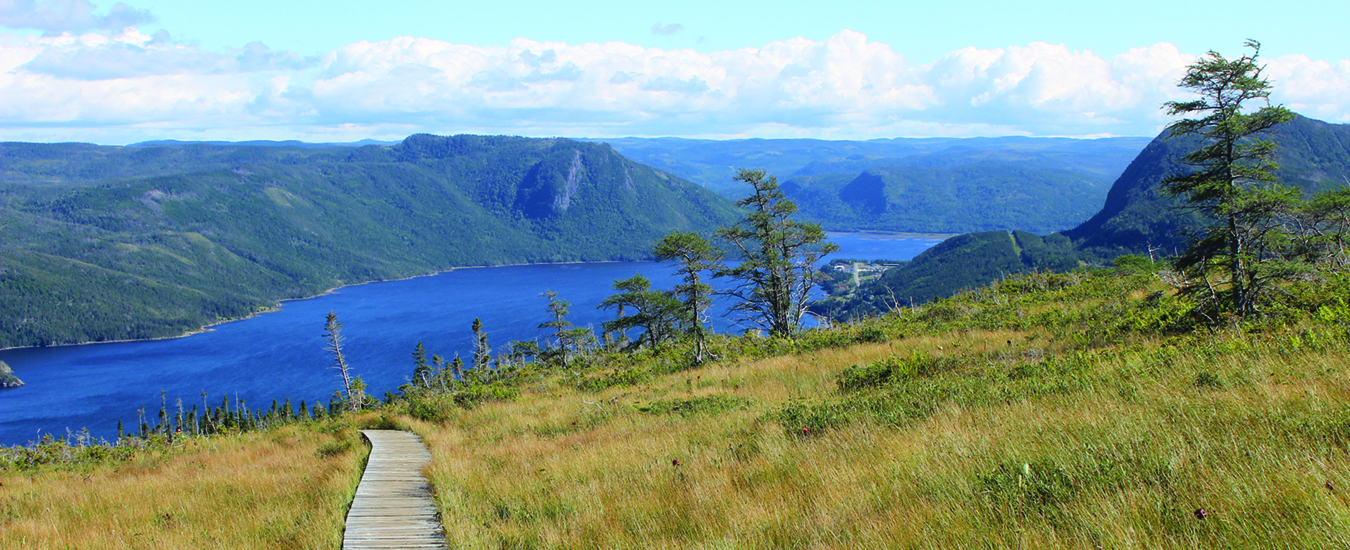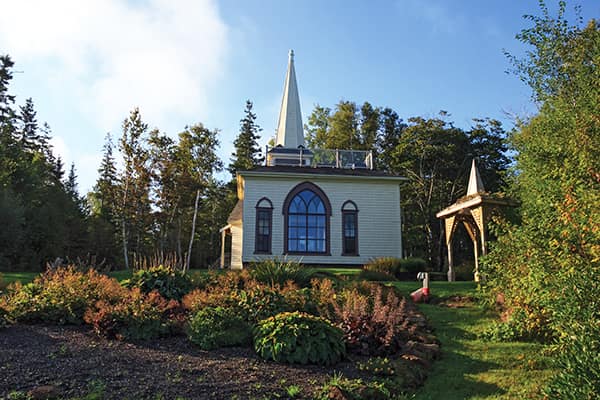Hiking and biking Gros Morne National Park
Story and photography by Darcy Rhyno
I’m having a hard time keeping up with my informal guide, Peter Thurlow. He’s an experienced mountain biker who enjoys showing visitors around his beloved Gros Morne National Park on Newfoundland’s west coast. We’re cycling the Bakers Brook Falls Trail, which Thurlow knows like the back of his hand and considers an easy to moderate ride.
I’ve done a little off road biking, but I’m twice his age, so pumping my legs to climb the short, steep inclines and power over all the roots and rocks is taking its toll. My legs and lungs are burning, so I’m relieved when we hit a flat stretch of bog spanned by a boardwalk.
We’ve gained enough altitude to see over the shrubbery clear to the ocean with nothing but a few stumps to interrupt the view. From here on, it’s an easy pedal to the end of the trail where a steady thunder is vibrating in the air around me. We lean our bikes against a fence and follow a short path down slippery stairs to a ledge with a view of a horseshoe shaped waterfall.
By now, I shouldn’t be surprised when I come upon such a natural wonder, given that they seem to be around every corner in Gros Morne. Thurlow leads the way to three lookoffs, each with a different perspective on the raging white water, tumbling down a series of rocky ledges before reaching the final Big Falls. We take time at each to marvel at the reward for all that strenuous cycling.
The favourites
The Bakers Brook Falls Trail is also a favourite of Rebecca Stone, co-owner with her husband Ian Stone of Tour Gros Morne. They offer guided hiking trips in the park that range from a couple of easy hours of walking to several days of strenuous trekking. Rebecca Stone says the best time to hike Bakers Brook is in spring, and for good reasons. “It’s a 10-kilometre loop trail with boardwalks and takes you through thousands of wild flowers. Then at the end you get to a beautiful waterfall.”
This is just one of 20 Gros Morne trails for day hiking, some of which are also suitable for mountain biking. At the top of Stone’s list is a trail called The Big Lookout. “It’s a full eight-hour hike that is unmarked,” Stone says, which means hikers need a guide like her. “It terraces up the rolling hills in the southern portion of the park, starting in Woody Point, then brings you to an elevation of 600 metres.” She says the view from the top is unparalleled. “Here, you get a 360-degree panoramic view of the entire park.”
Guests who sign up with Tour Gros Morne really enjoy The Big Lookout. The view is one thing, says Stone, but she adds, “the trail is soft on their feet, which is a plus when they’re hiking with us on a week-long adventure and the majority of the trails are very rocky.”
For those who prefer shorter outings, Stone says there’s a smaller version of this hike. It’s marked, so hikers can tackle it alone. “The Little Lookout is roughly two hours return. I consider this one to be the hardest and best short day hikes. It starts in the parking lot of the Discovery Centre just outside Woody Point and gives you a similar 360-degree view of the park.”
“We really do have hikes for all abilities,” Stone says. From boardwalks to steep, rocky hikes, there’s something for everyone, even those in wheelchairs. There’s one hike in particular that’s suitable to almost any level of ability, and it tells one of the oldest stories on the planet. The Tablelands Trail crosses a rocky red wedge of the Earth’s mantle—one of the few places on the planet it’s visible—heaved from beneath the crust half a billion years ago when two ancient continents collided.
As grand as it sounds, the hike is an easy hour or two stroll into a valley carved by glaciers. Strange flora like insectivorous pitcher plants and sundews thrive on the barren rock that’s devoid of nutrients and loaded with naturally toxic metals, preventing most other plants from growing. To make the walk even easier and more rewarding, a phone app and guided tour are available through the Discovery Centre.
The Tablelands is the starting point for another signature Gros Morne hiking trail. Green Gardens descends from the barrens of the Tablelands through lush forest and field to a dramatic volcanic coastline of cliffs, beaches, caves and sea stacks. The trail gets its name from the meadows of wildflowers overlooking the sea. Be prepared to fall in love with this gorgeous landscape, and for those who do, primitive campsites are available to stay the night and wake up in a little piece of Newfoundland heaven.
The star hike in Gros Morne is to the summit of the mountain that lends its name to the park. It’s the second highest peak on the island and the highest in the park. It’s the only day hike rated as difficult, but the rewards for this tough trek are many.
The first four kilometres is an easy, gradual ascent to a cluster of small ponds, itself a worthwhile walk for the natural surroundings and the view. From there, hikers can judge the conditions and a final assessment about whether or not to continue on to the steep boulder-strewn gulley that leads to the summit. Children should not try this part of the trail because hikers can be exposed to high winds, hot sun and rapid temperature fluctuations. Rebecca Stone warns hikers not to be fooled by the 10-kilometre length, which to some may seem an easy day. “You start at sea level, hike up to over 800 metres in elevation and back down again, all in roughly six to 10 hours.”
Views from the summit are the best in the park and rival anything else on Earth. On a clear day, hikers settle in on a rocky bluff to look out over the Long Range Mountains, Bonne Bay and the inland fjord called Ten Mile Pond. In the arctic alpine environment at the top, hikers can spot wildlife like caribou, snowshoe hare and rock ptarmigan usually associated with locations much further north.
How to prepare for Gros Morne trails
Whatever the trail, Stone says hikers need to understand where they are and take precautions. “People forget or don’t realize our hikes are situated on different geological features of the Appalachian Mountain Chain, the Earth’s mantle and even volcanic rock,” she says. “We suggest bringing durable hiking boots for the hard rocks you’ll be on all day.”
“Terrain may be more rugged than folks are used to,” says Katie Broadhurst, co-author with Alexandra Fortin of Hikes of Western Newfoundland. Proper preparation is particularly important when planning a hike in Gros Morne. “As a local guide, people often tell me the trails are rougher, it’s windier and it rains more than they are used to. Newfoundland is called the Rock for a reason. There are bogs and bugs. Come ready to hike with good footwear, good rain gear and a day pack prepared with the 10 essentials.”
Those who arrive well prepared to take on this rugged landscape with a good pair of hiking boots or a tough mountain bike—and that pack of essentials—will find hundreds of kilometres of trails, each with its own challenges and big rewards. “You can hike or ride and often see more animals than people, usually have a view of the ocean and get to explore some of the oldest land on the planet,” Broadhurst says.
Back on the Bakers Brook Falls Trail, when Peter Thurlow and I return from its big reward, we come across an interpretive sign entitled “A Broken Cycle” with little cartoon moose all over it. “It looks as though the forest here was smashed by a tornado,” the sign reads. “But it wasn’t beaten—it was eaten.”
The sign goes on to explain that this forest was devastated by a little caterpillar that left only a few birch and spruce standing among the devastation. When young trees began to grow again, the exploding moose population browsed on the new growth, preventing the forest from regenerating. Moose are an invasive species here and are changing the very nature of the park, which is a big deal because, among other things, Gros Morne is a UNESCO World Heritage Site.
Still, the presence of the big herbivore in the park has its benefits as well. I can pause here on this trail that would otherwise be a dark path through the woods and look out over one of the country’s great landscapes.

Left: Pitcher plant is the provincial flower for NL. Right: Ferns on the Gros Morne trail.
Add these activities to your Gros Morne to do list.
• Take a boat tour on Bonne Bay to see dolphins, whales and seabirds.
• Take the boat tour on Western Brook Pond, the park’s great inland fjord, to see its highest waterfalls.
• Bust a gut to the hilarity of musical comedy group, the Anchors Aweigh Band at the Ocean View Hotel in Rocky Harbour.
• Take the water taxi between Rocky Harbour and Woody Point for the views and to visit both enclave towns.
• Take in a show at the lovingly restored Woody Point Heritage Theatre.
• Check out the Lobster Cove Head Lighthouse in Rocky Harbour.
• Enjoy wild foraged mushrooms with your meal in Chanterelles Restaurant at the Sugar Hill Inn.
• See live theatre by the Gros Morne Theatre Festival in Cow Head.
• Check out the salt water aquarium and touch tank at the Bonne Bay Marine Station in Norris Point.
• Rent a sea kayak from Gros Morne Adventures in Norris Point to get out on the water.
Header caption: The welll named Lookout Trail.
Intro caption: Bakers Brook Falls.



